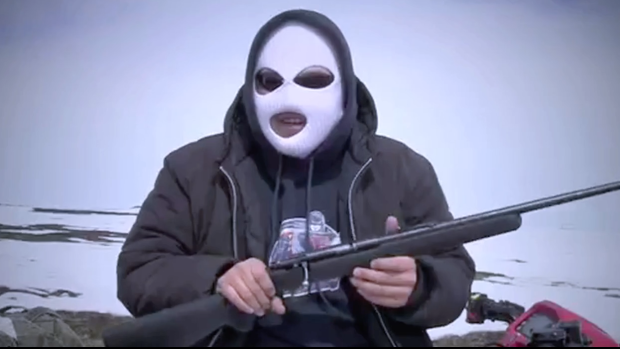White guys are at it again. Earlier this week, Quebec filmmaker Dominic Gagnon’s of the North enraged Inuit throat singer Tanya Tagaq as a “painful and racist” experimental documentary that used her music without permission. Tagaq took to Twitter to complain about the Montreal International Documentary Film Festival’s (RIDM) recent screening of the film.
And she’s not wrong to be upset. A bit of background: of the North compiles user-generated YouTube footage from Nunavut and Northern Quebec; it’s a mash-up of Arctic tundra landscapes populated with oil rigs, hunting, and skidoos but also Inuit men vomiting after drinking binges, and even a desperate Buñuel-esque edit of a vagina that cuts into a video of a dog’s tail hair being trimmed.
Tagaq, who won the 2014 Polaris Prize for her critically-acclaimed album Animism and has collaborated with artists like Björk and Matthew Barney, later stated in an interview with APTN National News that “this one-sided, racist slight propagating violence and actual violence…disgusts me” and threatened to file a lawsuit if her music wasn’t removed. “I am fully out for blood.”
Gagnon’s first line of defence was pulling the ‘oppressed white guy’ card. “I am being bashed because I am a man and I am white. I am only a young man who lives on his own, in his own studio and I don’t see where the privilege comes.” he said in the same APTN news story, explaining he compiled the film from over 500 hours of discovered footage from amateur Inuit filmmakers. “I made this film with love.”
Gagnon acknowledged that he had zero contact or consultation with any Inuit people in the making of the film, a pointed portrayal of a community that has had a long-documented history in Canada of oppression. He didn’t attempt to go out into the geographic areas he sourced from, despite receiving a research grant from the Conseil des arts et des lettres du Québec. He also claimed that he makes no money from his films, but of the North is in fact available from the Canadian Filmmakers Distribution Centre: the documentary can be rented for $225 CDN or purchased for $450 CDN. Needless to say, the film has been on the film festival circuit, even winning an award at the Visions du Réel in Switzerland.
The swift national backlash and negative media coverage led Gagnon to remove Tagaq’s music from the film. She withdrew her lawsuit, but continues to publicly critique RIDM’s programming. (Apparently, the executive director of French programming at the National Film Board ended up blocking her on Twitter when Tagaq tried to engage the public servant in a dialogue.)
The controversy has shed light on the challenges around mash-up artists engaging in research-based practices that veer dangerously into problematic ethnography. In his defence, Gagnon has frequently situated his mash-up work in copyleft values. Ever since an injury blinded his one eye leaving him unable to use a camera, he has worked with found amateur videos as his source material. He has collaged censored YouTube webcam clips (Rip In Pieces America) and conspiracy theorist rants from mostly redneck Americans (Pieces and Love and All to Hell) to elaborate on broader issues, like identity crises, terror and apocalypse cultures. Despite critical acclaim, he has expressed interest in marketing his work to “strippers, truckers and all other kind of workers” instead of the privileged video art audience.
But, like most oppressed white guys, Gagnon refuses to acknowledge his own subjective lens. He consistently re-contextualizes the amateur work of online communities thus deliberately shaping the work. The user is absent, and is not allowed any agency whatsoever in their representation. It’s the same way Alan Lomax deliberately shaped his archive-gathering of Southern black music as “folk constructions”.
Gagnon also doesn’t acknowledge the practicalities for an independent filmmaker to adopt copyleft values; user-generated video content is free to use, unlike copyrighted material. When I worked as an interactive editor for a media company, a colleague and I were tasked to create viral content—like a supercut of grandparents discovering Photobooth for the first time—because it would prop the monthly page views of the company’s website and we wouldn’t run into a copyright claim. Even though Gagnon goes to great efforts to credit and acknowledge his sources, it often feels like lip service for a form of a collaging that is dangerously enthralled with its aesthetics.
And I’m not alone in thinking about Gagnon’s murky disorienting context. In his recent of The North review, Film Comment’s Eric Hynes commented on how “Gagnon’s project both functions as a freestanding work of art and projects away from itself…it’s found footage montage as gonzo ethnography.”
Therein lies the rub. Dominic Gagnon gets to rewrite a history: in this case, committing a violent portrayal of indigenous realities lacking any sort of dialogue or meditation on the internet self-expressions of his subjects. To dismiss his collage work as a benign gesture underestimates his invisible, heavy hand in contextualizing a harmful context.



Comments on this entry are closed.